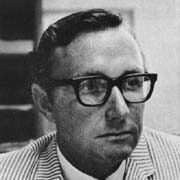John Griffin
- 1968

Fellowship Title:
- Pacific Islands
Fellowship Year:
- 1968
FA’A Samoa Faces the World
313 Anolani St. Honolulu, Hawaii Western Samoa is the home of the tribe that did not lose its head. Instead its 135,000 people have embarked on one of the more isolated but interesting experiments in the Pacific Area. It involves trying to preserve the biggest and perhaps finest remaining example of Polynesian culture. In the process, Western Samoa is several things: It is, in political status, ahead of most Pacific areas — the first Polynesian state to become independent in the 20th Century. This was formally accomplished on January 1, 1962, when New Zealand gave up its United Nations colonial mandate. It is much different from American Samoa, the U.S. territory some 50 miles away. For one thing, Western Samoa is much bigger, some five times so in population and 15 times in land area. One of its two main islands, Upolu, is the size of Tahiti or Oahu, Hawaii’s capital island; most of the population is on Upolu. The other main Samoan island, Savaii, is even larger. Equally important is the point that where the
Coming of Age Via ETV
313 Anolani St. Honolulu, Hawaii The scene was not unlike those repeated thousands of times in the last century in colonial islands around the South Pacific: The Great White Governor was arriving for a ceremonial visit and the men of the small out-islands were waiting in a sturdy longboat to bear him in through the surf past the dangerous coral reef. In this particular island of Tau in the Manua Group of American Samoa it was certainly that way when anthropologist Margaret Mead was there in the 1920s doing research for her book, Coming of Age in Samoa. Now, to be sure, there were some differences: For one, the governor, his entourage of chiefs, officials, and guests arrived at Tau on a high-speed launch, albeit after a pounding five-hour trip from Pago Pago on the main island of Tutuila that had made virtually everyone a retching wreck from seasickness. For another, the purpose of the visit was to dedicate a high school where the major medium of instruction is television beamed from the
American? Samoa?
SUVA, FIJI Rural Tutuila shoreline Even after Hawaii there is a spectacular beauty in American Samoa’s patterns of reef and rugged green mountain. Samoa’s people smile more and wave to both newcomers and the more permanent palangis or foreigners. Instead of going right into Pago Pago, I stayed with friends in rural Leone, across Tutuila Island near the airfield. Toward sunset we drove down to the far end of the island, past idyllic beachside villages where lamps and cooking fires flickered in the open sides of the beehive-shaped fales or Samoan homes. It was indeed the far Pacific at last, far from the American scene. Yet two hours later a news broadcast brought first word of Senator Robert Kennedy’s shooting. We went down to the new radio station where the bulletins were coming in. A young Samoan announcer working with the American manager shook his head in sadness and dismay as he ripped them off the machine. He read them directly on the air, translating into Samoan as he went. We drove home. In the fales the transistors, along with the
New Pacific Primer II
Honolulu, Hawaii June 8, 1968 You can be a sort of coconut Clausewitz looking at the Pacific Islands today. Or a student of comparative colonialism. Or a jet age dreamer of a new ore of political and economic development. There are many matters worth considering about this seven thousand mile sweep of sea, island, and people called Oceania. But some of the most important are summed up in four words — security, politics, transportation, and tourism. In cold honesty, security seems the major concern of the U.S. It comes in several forms, but rightly or wrongly most think in terms of military need and strategy. It is possible to take the view that the scattered islands of the Pacific are not that important any more in terms of U.S. national security. Some argue that talk of bases and national interest here represents essentially World War II thinking in the age of satellites, missiles, and nuclear submarines. After all, they say, we have Hawaii, our major bastion, and Guam as an advance base. Military men and
New Pacific Primer – I
Honolulu, Hawaii June 2, 1968 The following is a view of the Pacific Islands from Hawaii based on previous travels, reading and talks with area scholars, visiting islanders and concerned U.S. officials. It is a starting point for a year of study and travel in the area under an Alicia Patterson Fund Award. The writer is on leave from his position as editorial page editor of the Honolulu Advertiser. My favorite friend these days is one who wrote from Washington to this effect: “A year in the Pacific Islands sounds like a dream. But you must have mixed emotions about leaving behind politics, the peace talks, urban unrest, the university situation, etc. This is a big year, maybe a turning point for the U.S.” He has a point, that friend. Still my point is not to check out of the action, but rather to find how it relates to the largest geographical entity in the world, the Pacific with its thousands of islands and their people. So I keep thinking about the opening lines
